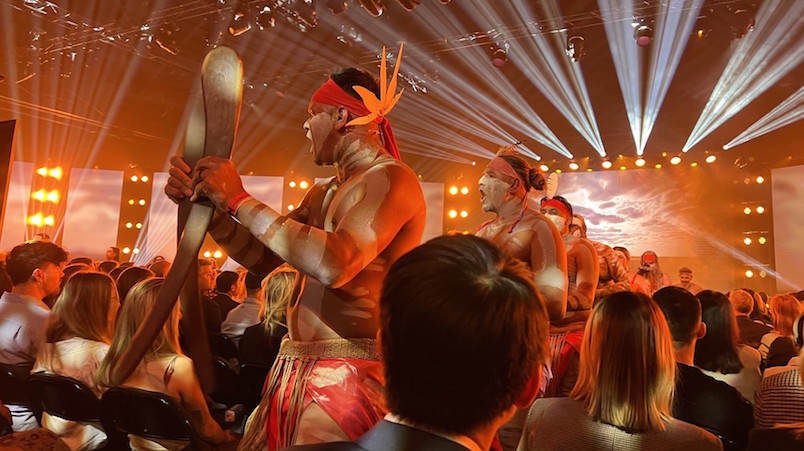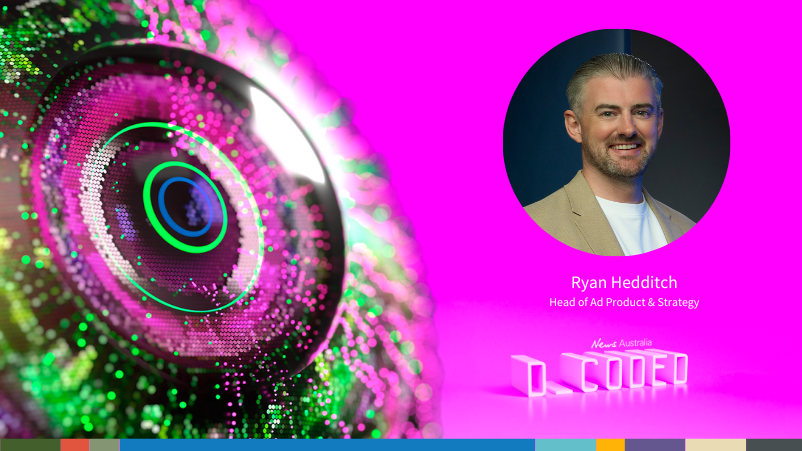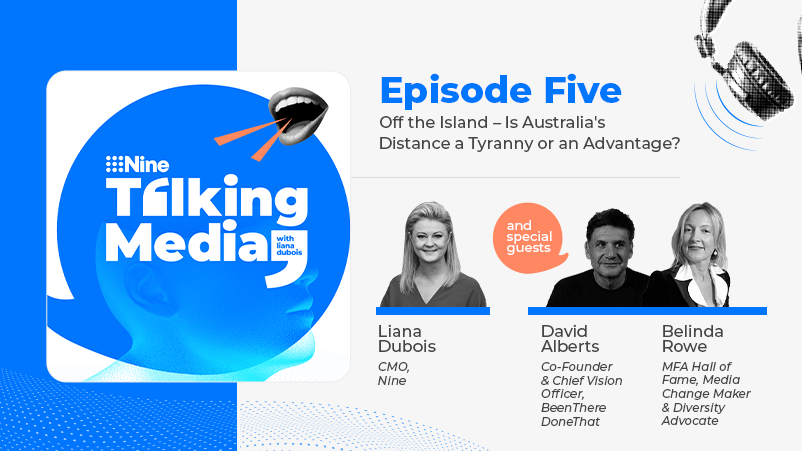Nine eyes $1.5bn, takes on Meta, Google with small business AI ad platform; enters retail media; counters News’ ecom play, touts $12.5m top Olympics package

Dancing to a different beat: Nine makes major play for small business dollars and Meta's lunch; dives into retailer media in defensive-offensive play; goes to town on Olympics.
Nine is taking on Meta and Google, targeting small businesses spending $1.5bn a year with the platforms via a self-serve platform that uses AI to build digital video ads in seconds and hyper-target them. It's aiming at 2.5m new advertisers for $500 a pop. The network is also entering Australia's fastest growing ad market: retail media. Michael Stephenson sees gaping opportunity to connect brand comms to point of purchase performance – or "sofa to store" – and hints at potential M&A down the track. Meanwhile, Nine's now going to market in earnest for the Olympics, touting top-end packages between $10.5m and $12.5m. There's room for 15 key partners, which now have a 40-day window to secure sponsorship before a broader market push. Advertisers aiming to get in front of Stan audiences may be disappointed – there's no current plans to join Netflix and Foxtel's Binge with an ad tier. But Stephenson said Nine is already targeting Stan audiences – and building more 'tribes', or segments, for brands keen to tap the streamers across the network's broader properties. On that front, Nine is making a concerted effort to combine all of its data across TV, publishing and audio to extract maximum value from circa 20m audience log-ins.
What you need to know:
- Nine is going after small and medium sized businesses that have traditionally been out of its reach due to the cost of linear TV advertising.
- It has launched Nine Ad Manager, a self-serve platform that via AI allows brands to create and run targeted ads on 9Now in seconds – complete with voiceover – for as little as $500. There are 2.5m SMBs to aim for versus Nine's current 1,500 advertiser pool on 9Now. Analysts in the Upfronts audience were licking their lips.
- Nine has also jumped into retail media and is in early conversations with the likes of Woolworth-owned Cartology, Coles 360 and David Jones to strike partnerships. Sales chief Michael Stephenson sees a gaping hole in the market and thinks Nine can fill it.
- Nine's big content play for next year – and the next decade – is its coverage of the Olympics, and Nine's now in market touting top-end sponsor packages of $12.5m.
- There are also other major sporting events, and a slate of new and familiar TV programs, with some old Stan hits chosen to run on Nine during primetime to promote new Stan releases.
- On Stan, some media buyers are baffled that Nine has again swerved from introducing a cheaper ad-tier to the SVOD. But Stephenson said the economics don't stack up – and Nine can target Stan audiences anyway via their log-in powered IDs across BVOD, publishing and audio.
- Nine's creating new Stan 'tribes' or segments to do just that – and is working to better integrate its 20m IDs across the broader business.
- Meanwhile, as News Corp makes some major commerce bets, Nine will now also push harder into ecom and affiliate marketing.
- This article is based on Nine's Upfront, earlier interviews with key execs, and a Market Voice podcast with Michael Stephenson and CMO Liana Dubois, which you can listen to here.
Right now [small businesses] spend $1.5bn on social video advertising. Nine Ad Manager provides them with a premium alternative ... we've got the scale to make this a really meaningful revenue line.
Nine takes on Meta, Google, eyes $1.5bn small business advertisers
Nine is bidding to scoop up the small business krill that has turned the likes of Google and Meta into advertising’s biggest whales. Chief Sales Officer Michael Stephenson aims to woo Australia’s 2.5 million SMBs that spend $1.5 billion annually on social video ads, bringing them into the fold with an AI-powered self-serve ad platform from $500 a pop.
SMB revenue currently accounts for less than 20 per cent of Nine’s overall pie. Stephenson reckons Nine can take a much larger chunk via Nine Ad Manager, expanding Nine’s customer base and clawing back dollars leaking from linear TV – circa $300m this year across the market.
“Right now [small businesses] spend $1.5bn on social video advertising,” said Stephenson. “Why do they do that? Because the social platforms have scale, they've got great first party data products and they are really easy to buy and transact with. If we want to enter that market, then we need to be at least as good as those guys [on all of that].”
He thinks Nine is equal terms of scale and data, but was behind on ease of transaction. To fix this, Nine licensed the DanAds platform – which is also used by Hulu – and added “an integrated AI engine to create video creative in real time”.
“It provides SMBs with a premium alternative to social video,” Stephenson told Mi3.
“I think we've done an okay job attracting advertisers to 9Now that don’t advertise on Nine, but the opportunity for us to grow in that space is enormous. Of the 1,500 clients that we currently have active on our platform, the revenue per brand is increasing at about 25 per cent year-on-year.”
How Nine Ad Manager works
Nine Ad Manager allows brands to use generative-AI tech to create bespoke, targeted TV ads that the network claims massively reduces wastage.
Nine’s head of ad and data products, Ben Campbell, added some detail and colour at the Upfront. Packages start at $500 all-in, he said, for ad creation, placement and analytics, which means local firms can target relevant segments – including those that might not be in their postcode, but soon will be.
Campbell cited Sydney chain Fratelli Fresh and its Entertainment Quarter restaurant by way of example.
“Let's say there's a Roosters versus Manly NRL match at Allianz Stadium in two weeks time. In the lead up to the game I want to reach NRL fans who live in the eastern suburbs and the northern beaches of Sydney so they choose Fratelli Fresh as a place to eat after the match,” said Campbell.
He demonstrated the platform to the audience, selecting the relevant postcodes – but crucially, only NRL fans that Nine has packaged-up from its 20m log-ins. “That means my ad will only be shown to NRL fans who live in the relevant areas Sydney,” per Campbell.
Small businesses are unlikely to have a TV ad ready to go. No problem, said Campbell.
“I can create an ad in minutes using artificial intelligence. First, I'll enter the URL of my website. Next I'll set the tone and the ad length and then I generate my ad. The platform collates all of the images, text, branding and colour schemes from my website. It creates a commercial using these assets, scripts the ad and applies a voiceover.”
He showed the audience an ad made “half an hour ago using AI in less than a minute.” For $500 including targeting and reporting, it was decent – and had analysts in the row behind Mi3 licking their lips and working out how much self-serve could add to Nine’s coffers.
A $50m SMB play?
Taking just three per cent of the existing $1.5bn SMB social video market would get Nine close to $50m in year one. Is Nine aiming that high?
“If it was $50 million [in year one], I would be ecstatic. I don't think it's anywhere near that to start with,” said Stephenson. He’s thinking mid-term, three to five years. “I am highly competitive and have high expectations … We've got the right strategy, right product and we've got the scale to be able to make this a really meaningful revenue line.”
Media buyers think it’s a smart move. Per Omnicom Media Group investment chief Kristiaan Kroon: “Nine Ads Manager looks impressive – and a step change from Australian media businesses.”
The self-serve platform will eventually add digital audio and publishing display inventory, but no timeframe has been set.
The retailer media players are highly effective at getting people from the shopping centre car park to the shelf. But Nine is incredibly effective at getting people from the sofa to the shopping centre car park and into the store.
Nine enters retailer media, moots M&A
Nine’s making a defensive-offensive play into retailer media. It’s bidding to carve out a slice of Australia’s fastest growing ad market as brands aim to tap shoppers just before they buy – and then use purchase and loyalty data to prove it worked.
With a unit dubbed RTLX, Stephenson thinks Nine can parachute into a market tipped globally to overtake TV within five years by enabling both brands and retailers play full funnel.
Locally the market is starting to get crowded. David Jones is the latest retailer to launch a standalone media business, touting more premium customers than its rivals – with data on circa 5.4 million of them. Front-runner Cartology is powering, Coles 360 is investing significantly to catch up and other retailers are poised to join the likes of Endeavour and Chemist Warehouse in building media businesses.
The retailers are all aiming to take brand budgets on top of trade marketing spend – and not just from their existing supplier-base. Many will also use their data to power buys across the web, including BVOD. Some will do the buy and take a margin on that media. All of which presents a threat to traditional media owners (and traditional agencies).
But Stephenson sees opportunity.
“It’s only part of the journey,” Stephenson told Mi3. “The retailer media players are highly effective at getting people from the shopping centre car park to the shelf. But Nine is incredibly effective at getting people from the sofa to the shopping centre car park and into the store.”
Right now, “your investment effectively allows you to connect with your consumer only at the closest point of purchase. What I'm suggesting is how do we build a complete through-the-line proposition that allows you to connect with them at scale at the top of the funnel all the way through to conversion at the bottom?”
Brands such as Steggles, Nestle and V2food have told Mi3 the same thing – and retailers acknowledge the need to better align brand and retail performance marketing end-to-end.
Nine will work with retailers and brands on content and formats while tapping Nine’s circa 20m logged-in audience data for sharper targeting. In the immediate term, he said Nine’s relationship with both retailers and their suppliers – both sides of the marketplace are major advertisers – provides a natural entry point.
But he’s thinking bigger than that, eyeing potential acquisitions down the track.
“Part two of [RTLX] is the triumvirate relationship that I can see between ourselves, retail media partner, and advertiser to create new business models, new affiliate programs, create new data and ad products, maybe into the future joint ventures or who knows, even M&A activity.”
In the meantime, he said RTLX will deliver a higher return on brands’ retail media investments, as well as the ability to track the conversion from audience to a brand’s site, brochure downloads, store visits and other campaign metrics.
We don't have plans right now to have advertising within Stan ... [and anyway] we have the ability to access those users ... We're creating a number of Stan tribes [i.e. segments] so advertisers who have a real desire to target streamers will be able to do that at scale across both 9Now and the rest of our digital platform.
Stan: no ads yet, but ‘brands can target them anyway’
While media buyers think Nine is missing a trick by keeping Stan ‘pure’ as other streamers push into ad tiers, Stephenson suggests there’s no need – for now. He said Nine can already target Stan subscribers around its properties for advertisers dead set on reaching streamers – and is building deeper targeting segments across both Stan and Stan sport.
“We don't have plans right now to have advertising within Stan. There’s a high propensity for consumers to pay for their subscriptions in Australia and we have incredibly high penetration. So we don’t believe the economics work and we're very comfortable right now to have Stan as a standalone product with its own point of differentiation,” per Stephenson
“We have eight and a half million signed in users into the platform [current and lapsed Stan subscribers], and therefore the ability to access those users as they engage with the rest of our digital ecosystem – and that’s what we have done,” he added. “We're creating a number of Stan or streaming tribes [i.e. segments] so advertisers who have a real desire to target streamers will be able to do that at scale across both 9Now and the rest of our digital platform.”
That said, some buyers think the continued streaming hold-out is contrarian, given the Nine is Australia’s most integrated media company with roots firmly in advertising.
“I guess we're fortunate because we already have an ad-funded streaming platform,” said Stephenson. “It's called 9Now … [so] at this point in time, there is no real need.”
Plus, he said a subscription business provides a safe harbour when things get rough. “It certainly does de-leverage us from market conditions, and that's proven to be a fairly significant advantage.”
But the network will start showing some of Stan’s programmes on free-to-air to help promote new Stan launches – and drive subscriptions.
Olympics: Revenue marathon, not sprint; $12.5m for top package
Much has been made of the Olympics’ $305m rights price tag – not least by former holder Seven. But that can be amortised and monetised over the next decade – and Nine’s making it the cornerstone of its content and growth strategy.
In the short-term, and short market, even the AOC is struggling to drum up major sponsors in key categories such as finance, telco and energy. But Stephenson is upbeat. It’s early days, he said, giving Mi3 some numbers on its key packages as it goes to market for the Paris games: $12.5m for ‘Flame’ sponsorship and $10.5m for ‘Torch.’ Nine’s seeking up to 15 such partners. If it gets close, that’s a big chunk recouped.
CMO Liana Dubois is aiming to ride the marketing and audience wave created by the Matilda’s push to the World Cup semis – with their next major competition in Paris – while bringing younger audiences into Nine through Olympic events like breakdancing, skating and surfing.
Dubois said it will be “the most accessible games ever seen”, with Nine’s 40 dedicated FAST channels and set-up meaning users can curate what they watch – for example by event or by athlete. Plus, advertisers can target those audiences across TV, audio and publishing by specific ‘tribes’ that Nine is now building.
“We have total media, total audio, and digital rights for the next 10 years and the feedback from market is overwhelmingly positive – because they’ve never been able to do this before,” said Stephenson. “Historically they've had to go to multiple providers to create one mega marketing platform. We can provide everything.”
Going to market in earnest
Nine has finished presenting its Olympic and Paralympic packages to International Olympic Committee and Australian Olympic Committee partners, who receive a 40-day exclusivity period before Nine can go out to the wider market.
Nine is offering partners up to 10-month Road to Paris campaigns, which it says allows brands to reach 98 per cent of Australians. It kicks off with January’s Winter Youth Olympic Games, runs through Paris in July and August, and concludes at the Paralympic Games in September.
The 9 Network’s coverage will be led by the Wide World of Sports team, and features Ally Langdon, James Bracey, Dylan Alcott, Sarah Abo, Karl Stefanovic, Brooke Boney, Alex Cullen, Todd Woodbridge, Leila McKinnon and Eddie McGuire.
Other former Olympians hired as sports experts include Ian Thorpe, Andrew Gaze, Giaan Rooney and Cadel Evans.
Publishing: ecom push to counter News
Rival News Corp has made some big bets on ecommerce, targeting BVOD, social and the $300m in ad revenue forecast to exit linear TV this year. Nine’s now pushing back, touting expanded ecom and affiliate marketing capability across its publishing suite of mastheads, which include The Age, The Sydney Morning Herald, The Brisbane Times and WAToday.
Per digital sales boss Nick Young, this will allow “advertisers to embed their products in our trusted environments and benefit from the online sales generated across our digital network”.
Nine said that advertisers can reach a monthly audience of 16.4 million consumers in verticals including tech, travel, style, beauty, parenting, living, kitchen, health and fitness with more to come.
Meanwhile, it's struck new deals for audience matching with Tealium and Snowflake, which increases the options for brands to target customers using their first party data against Nine's across the network.
Other product announcements include interactive ad units on 9Now, allowing brands to create “immersive experiences” and “shoppable moments” as well as via new FAST channels.
More sport, new shows
Aside from the Olympic Games, Nine is also broadcasting the Rugby World Cup on Stan, as well as the ICC Men’s Cricket World Cup later this year, in addition to its coverage of the NRL and Australian Open.
New TV programs for 2024 include gameshows Tipping Point Australia and Jeopardy! Australia, the drama series Human Error, which follows Detective Holly O’Rourke and her homicide team as a seemingly open-and-shut murder investigation threatens to destroy her career, her family, and her faith in justice. There is also a gardening makeover show, The Garden Hustle, real estate format Listing Melbourne and new renovation show, Budget Battlers.
Returning reality TV formats include Married At First Sight, LEGO Masters, The Summit, The Block, Love Island Australia, My Mum Your Dad. A local version of Gordon Ramsay’s Food Stars, which was promoted at last year's upfront but has not yet aired, is also the slate.
There's more detail in Nine's Mi3 Market Voice podcast. Get the download here.



